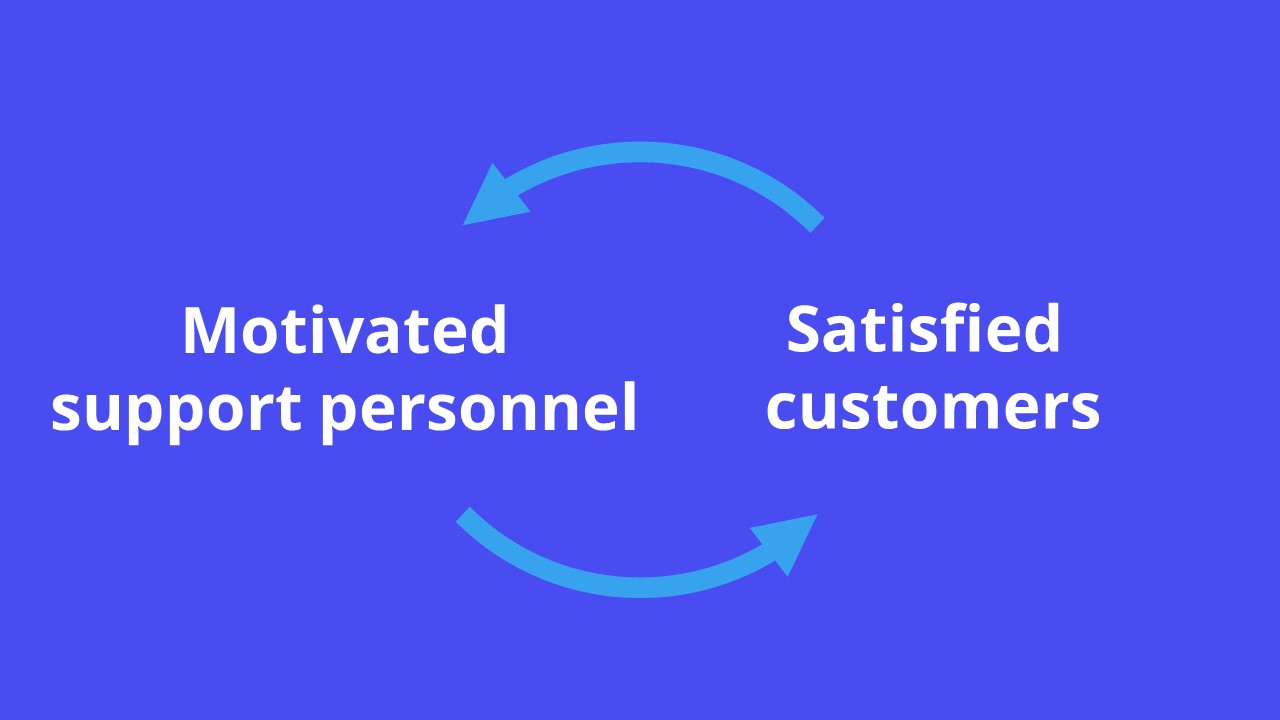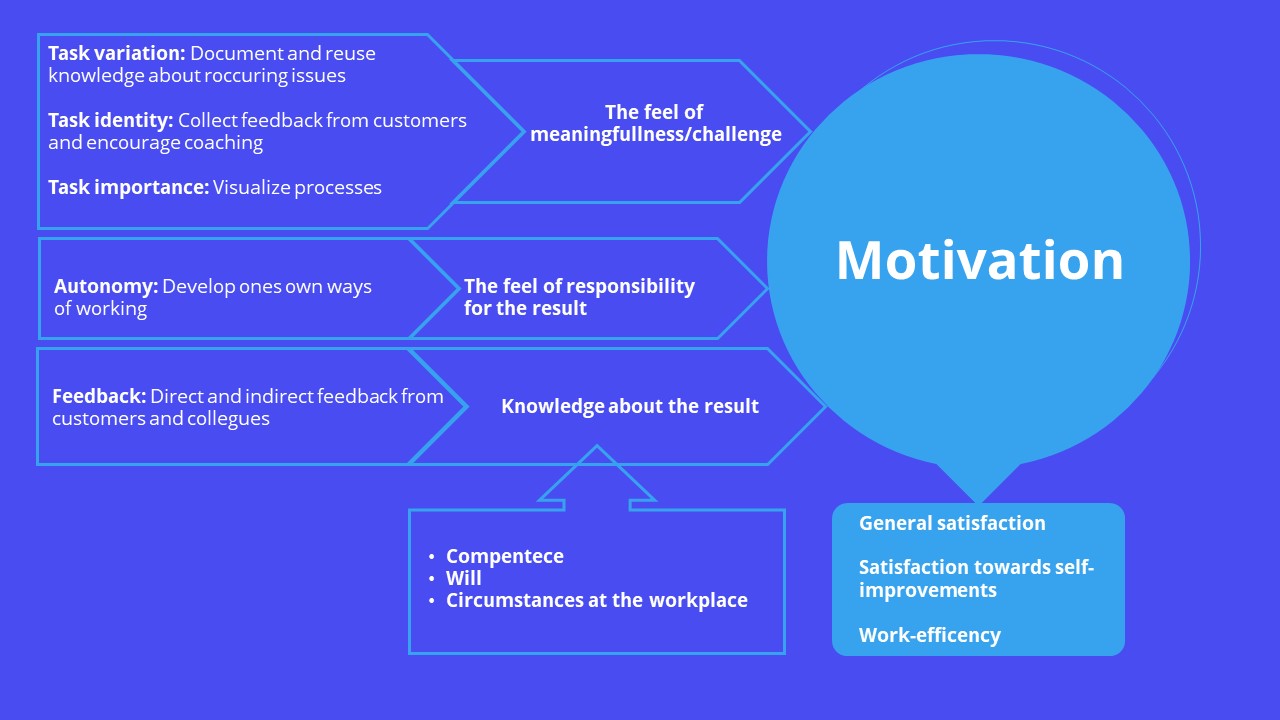First line support often answers the same questions over and over again. The work is repetitive and not very motivating. How can you fix this? Motivated support staff not only improves the working environment for the individual workers, and give them the driving force to do a good job - it also reflects in the form of satisfied customers, which in turn increases the motivation of support staff if they get to know the customer's positive feedback. A good circle!

According to Hackman and Oldham's proven work model of 1974, it is the task itself that primarily influences the motivation of an individual. The model says that three important prerequisites need to be in place for an employee to get motivation at work:
- The work is perceived as meaningful or challenging
- The employee experiences responsibility for the outcome of his work
- The employee will know the results of his work
Meaningful or Challenging Work
Hackman and Oldham mean that there are three characteristics of an assignment that affect the degree of meaning and challenge at work: task variation, task identity and the importance of the task.
How can you then vary the information of a support employee, when the job description itself is about answering recurring cases? To reduce the number of recurring cases, of course! By documenting the responses in knowledge articles that are reused when the matter appears, the support staff will not respond to the same thing over and over again. Instead, just send the link to the knowledge article! Or - better yet - publish the knowledge article in a self-help portal so that the customer can answer his own question before contacting support! When the simple repetitive cases are reduced, the support staff can devote their time to respond to more unusual, clear questions.
Tasks identity is about the importance of the work effort for the final product - that is, the employee actually performs what is delivered to the customer. According to Hackman and Oldham, an employee's work becomes more motivating if it is involved in whole processes rather than a small part of them. Achieve this by adding documenting feedback and wishes from the customers as a task for the support staff. The documentation should then be sent to the person whom is responsible for the development of your product. Then let the support staff return to the customer themselves if the suggestions have been met. That way, the employee can participate in the whole process of developing a better service. Also encourage giving tips and coaching to the customer regarding the use of your services. Their work then not only answers short questions and sends coaching to others - without assisting all the way through the provision of better service. In cases where the support employee only performs a small part of a large process - make sure the process is visualized so that there is a clear beginning and end of the task. In the process, they can see how the work progresses after completion of their own task. It is also important that feedback is given when the process is completed.
The third feature, the meaning of the task, describes the extent to which the task is important to others - both for the customer and for colleagues in the organization. Here too, process descriptions increase the understanding of how other people's work is influenced by their own efforts. In the process, the employee can see that there are other people who are actually completely dependent on their own efforts. Such a person is often the customer - which in some cases does not go on in his work without the help of the support employee. Increased understanding of how the everyday life of the customer is facilitated by fast and helpful answers increases the importance of the support tasks.
Experienced Responsibility For the Outcome of the Work
Autonomy is the property that, according to Hackman and Oldham, influences the employee's responsibility for the outcome of the work. By allowing the employee to decide on certain routines and working methods, this can be achieved. Use process charts and let support staff draw up how they work in certain feeds - for example, how often follow-up on cases should happen or how customers want to be taken and followed up.
Knowledge of the Result
Through feedback, the employee gets knowledge of the results of his work. Customer satisfaction surveys sent after completion of support cases are a good way to provide feedback to the support staff on what is good and what can be improved. Therefore, consider not only to use the results of such surveys to measure KPIs in the organization, but also to provide feedback to support staff.
However, in order for feedback to give the greatest possible effect, it should preferably be direct - thus given in connection with performance and not too long afterwards. If a customer is satisfied with the support work, it is not unusual for it to thank for good service, and the result of it will be a direct feedback. As a manager, it is important to pay close attention to such comments and gladly tell the whole organization that support is doing a good job. That way, feedback to support staff doubles - both from customers and colleagues! Of course, the opposite also occurs: the feedback from the customer is negative. Then, as a manager, follow up and give constructive suggestions on how to work better next time.
Also encourage other employees to return to support when they hear from customers that they are satisfied. Make sure the support staff know how important their efforts are to maintain good customer relationships and achieve good results.
Individual conditions
In order for the above properties to really lead to motivation for the individual, Hackman and Oldham require that certain conditions are in place:
- The employee has the skills required by the work.
- The employee has a desire to gain personal responsibility and development.
- The circumstances surrounding the employment are such that it feels safe, that there is a good relationship with the boss and colleagues etc.
Summary
The image below summarizes the factors that influence motivation, and the suggestions on how a support employee's duties can be adapted to increase his motivation. To create the highest possible motivation, as many as possible of the characteristics of a task should be combined. The result: General Satisfaction, Satisfaction with Development and Work Efficiency - and the Good Circle is Underway!



